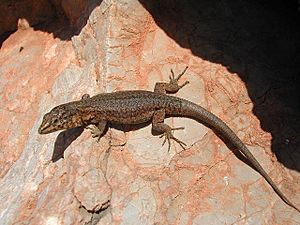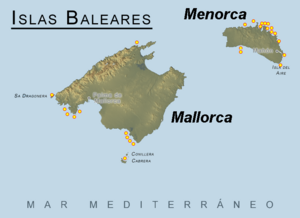Lilford's wall lizard facts for kids
Quick facts for kids Lilford's wall lizard |
|
|---|---|
 |
|
| Conservation status | |
| Scientific classification | |
| Genus: |
Podarcis
|
| Species: |
lilfordi
|
 |
|
| Geographic range | |
| Synonyms | |
|
|
The Lilford's wall lizard (Podarcis lilfordi) is a small lizard. It is found only on the Balearic Islands in Spain. These islands are located in the Mediterranean Sea. This lizard is special because it lives only in this one place. Scientists call this being "endemic."
Originally, these lizards lived all over the Balearic Islands. But over time, new animals were brought to the islands. These new animals, like cats, became predators. This caused the Lilford's wall lizard to disappear from the main islands. Now, they mostly live on small, uninhabited islets. On almost every islet, a slightly different type of the lizard has developed. Sadly, their homes are shrinking, which puts them in danger.
Contents
Why is it called Lilford's wall lizard?
This lizard is named after a British bird expert. His name was Thomas Powys, 4th Baron Lilford. He studied many animals on the Balearic Islands. So, the lizard was named P. lilfordi in his honor.
What does Lilford's wall lizard look like?
Lilford's wall lizards are usually small. They grow up to about 8 centimeters (3 inches) long from their snout to their tail base. Their tail is even longer, about 1.8 times the length of their body. They have a strong, smooth body with a short head.
Their skin color can be green or brown. It changes a lot depending on which island they live on. They often have a light stripe along their sides. Sometimes, they have dark marks or three dark lines on their back. Their sides might have a net-like pattern. The underside of their body is usually white, cream, or pink. Their throat can have darker spots. Young lizards sometimes have a blue tail.
Where does Lilford's wall lizard live?
This lizard is native to the islands of Menorca and Mallorca. These are part of the Balearic Islands. It also lives on the Cabrera Archipelago, south of Mallorca. Plus, it lives on many small rocky islets nearby.
However, these lizards have disappeared from the two large islands. They are now found only on the smaller islets.
What is its habitat like?
Lilford's wall lizards live in low-lying areas. They mostly stay on the ground. Their favorite places are rocky areas and scrubland. Scrubland is land covered with small bushes. On Cabrera, they can also be found in woodlands.
Behaviour and diet
Lilford's wall lizards are quite calm. You can often get close to them. They mainly eat insects, spiders, and other small creatures. They also eat snails. Sometimes, they eat plants, like flowers and fruits. They even drink nectar and eat pollen.
Some plants that grow only on the Balearic Islands need these lizards. The lizards help to pollinate these plants. This means they help the plants make seeds. Other plants they help include the mastic tree and wild leek.
These lizards are also clever about finding food. They sometimes eat scraps dropped by gulls near their nests. They also visit the nests of Eleonora's falcon. There, they eat leftover prey and flies. Sometimes, they even eat younger lizards or the tails of other lizards of their own kind.
Reproduction and life cycle
Lilford's wall lizards breed during the summer. A female lizard can lay up to three groups of eggs. Each group has one to four eggs. The eggs are quite large for a lizard of this size. They weigh about 0.63 grams.
The eggs hatch in about eight weeks. The baby lizards are small when they hatch. They are about 3 to 3.5 centimeters (1 to 1.4 inches) long from snout to vent.
Conservation status
The number of Lilford's wall lizards is decreasing. They used to be very common on Menorca and Mallorca. But they are no longer found there. This might be because of new animals brought to the islands. Cats, false smooth snakes, and weasels are some of these new predators.
The total area where these lizards now live is very small. It is less than 500 square kilometers (193 square miles). Because of this, the IUCN (International Union for Conservation of Nature) lists them as "Endangered." This means they are at high risk of disappearing forever.
Subspecies
There are many different types of Lilford's wall lizards. Scientists have found twenty-seven recognized subspecies. Many of these subspecies live on only one specific island or islet. For example, Podarcis lilfordi lilfordi lives on Aire islet. Another, Podarcis lilfordi gigliolii, is found on Dragonera islet. Sadly, one subspecies, Podarcis lilfordi rodriquezi, is now extinct. It used to live on Ratas Island.
See also
 In Spanish: Lagartija balear para niños
In Spanish: Lagartija balear para niños


